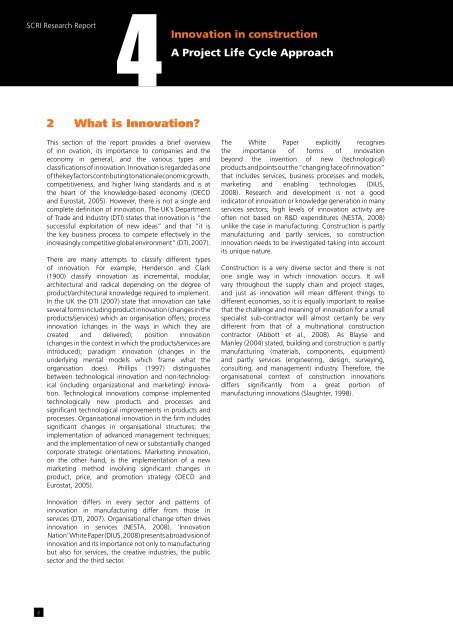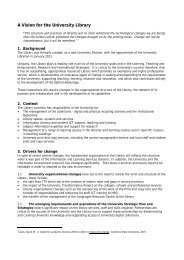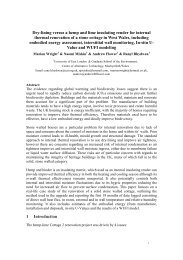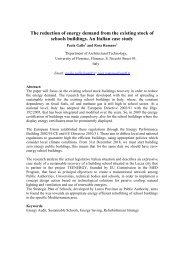Innovation in Construction A Project Life Cycle Approach
Innovation in Construction A Project Life Cycle Approach
Innovation in Construction A Project Life Cycle Approach
Create successful ePaper yourself
Turn your PDF publications into a flip-book with our unique Google optimized e-Paper software.
SCRI Research Report4<strong>Innovation</strong> <strong>in</strong> constructionA <strong>Project</strong> <strong>Life</strong> <strong>Cycle</strong> <strong>Approach</strong>2 What is <strong>Innovation</strong>?This section of the report provides a brief overviewof <strong>in</strong>n ovation, its importance to companies and theeconomy <strong>in</strong> general, and the various types andclassifications of <strong>in</strong>novation. <strong>Innovation</strong> is regarded as oneof the key factors contribut<strong>in</strong>g to national economic growth,competitiveness, and higher liv<strong>in</strong>g standards and is atthe heart of the knowledge-based economy (OECDand Eurostat, 2005). However, there is not a s<strong>in</strong>gle andcomplete def<strong>in</strong>ition of <strong>in</strong>novation. The UK’s Departmentof Trade and Industry (DTI) states that <strong>in</strong>novation is “thesuccessful exploitation of new ideas” and that “it isthe key bus<strong>in</strong>ess process to compete effectively <strong>in</strong> the<strong>in</strong>creas<strong>in</strong>gly competitive global environment” (DTI, 2007).There are many attempts to classify different typesof <strong>in</strong>novation. For example, Henderson and Clark(1900) classify <strong>in</strong>novation as <strong>in</strong>cremental, modular,architectural and radical depend<strong>in</strong>g on the degree ofproduct/architectural knowledge required to implement.In the UK the DTI (2007) state that <strong>in</strong>novation can takeseveral forms <strong>in</strong>clud<strong>in</strong>g product <strong>in</strong>novation (changes <strong>in</strong> theproducts/services) which an organisation offers; process<strong>in</strong>novation (changes <strong>in</strong> the ways <strong>in</strong> which they arecreated and delivered); position <strong>in</strong>novation(changes <strong>in</strong> the context <strong>in</strong> which the products/services are<strong>in</strong>troduced); paradigm <strong>in</strong>novation (changes <strong>in</strong> theunderly<strong>in</strong>g mental models which frame what theorganisation does). Phillips (1997) dist<strong>in</strong>guishesbetween technological <strong>in</strong>novation and non-technological(<strong>in</strong>clud<strong>in</strong>g organizational and market<strong>in</strong>g) <strong>in</strong>novation.Technological <strong>in</strong>novations comprise implementedtechnologically new products and processes andsignificant technological improvements <strong>in</strong> products andprocesses. Organisational <strong>in</strong>novation <strong>in</strong> the firm <strong>in</strong>cludessignificant changes <strong>in</strong> organisational structures; theimplementation of advanced management techniques;and the implementation of new or substantially changedcorporate strategic orientations. Market<strong>in</strong>g <strong>in</strong>novation,on the other hand, is the implementation of a newmarket<strong>in</strong>g method <strong>in</strong>volv<strong>in</strong>g significant changes <strong>in</strong>product, price, and promotion strategy (OECD andEurostat, 2005).The White Paper explicitly recogniesthe importance of forms of <strong>in</strong>novationbeyond the <strong>in</strong>vention of new (technological)products and po<strong>in</strong>ts out the “chang<strong>in</strong>g face of <strong>in</strong>novation”that <strong>in</strong>cludes services, bus<strong>in</strong>ess processes and models,market<strong>in</strong>g and enabl<strong>in</strong>g technologies (DIUS,2008). Research and development is not a good<strong>in</strong>dicator of <strong>in</strong>novation or knowledge generation <strong>in</strong> manyservices sectors; high levels of <strong>in</strong>novation activity areoften not based on R&D expenditures (NESTA, 2008)unlike the case <strong>in</strong> manufactur<strong>in</strong>g. <strong>Construction</strong> is partlymanufactur<strong>in</strong>g and partly services, so construction<strong>in</strong>novation needs to be <strong>in</strong>vestigated tak<strong>in</strong>g <strong>in</strong>to accountits unique nature.<strong>Construction</strong> is a very diverse sector and there is notone s<strong>in</strong>gle way <strong>in</strong> which <strong>in</strong>novation occurs. It willvary throughout the supply cha<strong>in</strong> and project stages,and just as <strong>in</strong>novation will mean different th<strong>in</strong>gs todifferent economies, so it is equally important to realisethat the challenge and mean<strong>in</strong>g of <strong>in</strong>novation for a smallspecialist sub-contractor will almost certa<strong>in</strong>ly be verydifferent from that of a mult<strong>in</strong>ational constructioncontractor (Abbott et al., 2008). As Blayse andManley (2004) stated, build<strong>in</strong>g and construction is partlymanufactur<strong>in</strong>g (materials, components, equipment)and partly services (eng<strong>in</strong>eer<strong>in</strong>g, design, survey<strong>in</strong>g,consult<strong>in</strong>g, and management) <strong>in</strong>dustry. Therefore, theorganisational context of construction <strong>in</strong>novationsdiffers significantly from a great portion ofmanufactur<strong>in</strong>g <strong>in</strong>novations (Slaughter, 1998).<strong>Innovation</strong> differs <strong>in</strong> every sector and patterns of<strong>in</strong>novation <strong>in</strong> manufactur<strong>in</strong>g differ from those <strong>in</strong>services (DTI, 2007). Organisational change often drives<strong>in</strong>novation <strong>in</strong> services (NESTA, 2008). ‘<strong>Innovation</strong>Nation’ White Paper (DIUS, 2008) presents a broad vision of<strong>in</strong>novation and its importance not only to manufactur<strong>in</strong>gbut also for services, the creative <strong>in</strong>dustries, the publicsector and the third sector.2
















